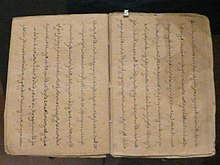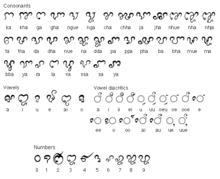Cham font
The Cham script is an Abugida used to write the Cham language , an Austronesian language spoken by some 230,000 people of the Cham people in Vietnam and Cambodia . It is written horizontally from left to right.
history
The Cham script is a derivative of the Brahmi script of India, which in turn derives from the Aramaic script . Cham was one of the first scripts to develop from the South Indian Brahmi script Vatteluttu sometime around the year 200 AD. It came to South India as part of the spread of Hinduism and Buddhism . Hindu stone temples of the Champa civilization contain both Sanskrit and Chamic stone inscriptions. The earliest inscriptions in Vietnam were found in the Mỹ-Sơn temple complex. Dated around AD 400, the oldest is written in incorrect Sanskrit. Later inscriptions alternate between Sanskrit and the Cham language of those times.
Cham kings studied classical Indian texts e.g. B. the Dharmaśāstra and inscriptions refer to Sanskrit literature . Eventually, while the Cham languages and Sanskrit influenced each other, the Cham culture adopted Hinduism and the Cham people were finally able to adequately express the Hindu religion in their own language. By the 8th century AD, the Cham script had outgrown Sanskrit and the Cham language was in full use. Most of the surviving manuscripts focus on religious rituals, epic battles and poems, and myths.
Modern Cham languages have the Southeast Asian language federation characteristics of monosyllabicity ( monosyllabicity ), tonality and glottalization . Even so, the Cham languages have reached mainland Southeast Asia in two syllables and non-tonally. The script had to be changed to accommodate these changes.
The Cham people currently live in two groups: the Western Cham in Cambodia and the Eastern Cham ( Phan Rang Cham ) in Vietnam. In the first millennium AD, the Cham languages were a chain of dialects along the Vietnamese coast. The breaking of this chain into distinct languages came after the Vietnamese pushed south and led the Cham people to retreat into the highlands, with some such as B. the Phan Rang Cham became part of the Vietnamese-ruled society in the lowlands. The division of the Cham people into two ethnic groups took place immediately after the capital was overthrown by the Vietnamese. Both use distinct varieties of the Cham script, with the western Cham being predominantly Muslim and nowadays preferring to write their language in Arabic script . The eastern group consists mainly of Hindus who continue to use the Cham script. During the French colonial era, both groups had to use the Latin alphabet .
use
The script is highly valued in the Cham culture, but that does not mean that many people learn it. Efforts have been made to simplify spelling and encourage learning to write, but these have had limited success. Boys traditionally learned the script around the age of 12, when they were old and strong enough to tend the water buffalo. However, women and girls typically did not learn to read.
structure
As Abugida, Cham only writes the individual consonants, supplemented by mandatory diacritical marks for vowels that are added to the consonants.
Most consonant letters, e.g. B. [b] , [t] , or [p] contain the inherent vowel [a] , which does not need to be written. The nasal consonants [m] , [n] , [ɲ] and [ŋ] (the last two are transcribed in Latin with nh and ng ) are exceptions and have the inherent vowel [ɨ] (transcribed with eu ). A diacritical mark called kai that does not appear with the other consonants is written under a nasal conson to write the [a] vowel.
Cham words contain only vowel syllables or consonant-vowel (consonant) syllables (V and CV (C)). There are several characters for final consonants in the Cham script; other consonants are simply given a longer tail on the right to indicate the lack of an ending vowel.
Unicode
The Unicode block for the Cham font Cham is U + AA00 .. U + AA5F. Gray shading indicates unassigned code points .
Individual evidence
- ↑ a b c Thurgood, Graham. From Ancient Cham to Modern Dialects: Two Thousand Years of Language Contact and Change (German: From the old Cham language to modern dialects: 2000 years of language contact and change). Honolulu: University of Hawaii Press, 1999.
- ↑ a b c Claude, Jacques. "The Use of Sanskrit in the Khmer and Cham Inscriptions." (German: The use of Sanskrit in the Khmer and Cham inscriptions outside India). In: Sanskrit Outside India (Vol. 7, pp. 5-12). Leiden: Panels of the VIIth World Sanskrit Conference. 1991.
- ^ A b c d Blood, Doris E. "The Script as a Cohesive Factor in Cham Society" (German: The writing as a connecting factor in the Cham society). In Notes from Indochina on ethnic minority cultures . Ed. Marilyn Gregerson. 1980 p35-44
- ↑ Trankell & Ovesen 2004
- ↑ Blood 1980a, b, 2008, Brunelle 2008
literature
- Blood, Doris (1980a). Cham literacy: the struggle between old and new (a case study). Notes on Literacy 12, 6-9.
- Blood, Doris (1980b). The script as a cohesive factor in Cham society. In Notes from Indochina , Marilyn Gregersen and Dorothy Thomas (eds.), 35-44. Dallas: International Museum of Cultures.
- Blood, Doris E. 2008. The ascendancy of the Cham script: how a literacy workshop became the catalyst. International Journal of the Sociology of Language 192: 45-56.
- Brunell, Marc. 2008. Diglossia, Bilingualism, and the Revitalization of Written Eastern Cham. Language Documentation and Conservation 2.1: 28-46. (Web based journal)
- Moussay, Gerard (1971). Dictionnaire Cam-Vietnamien-Français . Phan Rang: Center Culturel Cam.
- Trankell, Ing-Britt and Jan Ovesen (2004). Muslim minorities in Cambodia. NIASnytt 4, 22-24. (Also on Web)


